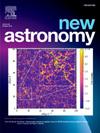Prospects for high-resolution probes of galaxy dynamics tracing background cosmology in MaNGA
IF 2.1
4区 物理与天体物理
Q2 ASTRONOMY & ASTROPHYSICS
引用次数: 0
Abstract
Large- galaxy surveys offer unprecedented opportunities to probe weak gravitation in galaxy dynamics that may contain correlations tracing background cosmology. Of particular interest is the potential of finite sensitivities to the background de Sitter scale of acceleration , where is the Hubble parameter and is the velocity of light. At sufficiently large , this is possibly probed by ensemble-averaged (“stacked”) rotation curves (RCs) at resolutions on par with present estimates of the Hubble parameter . Here, we consider the prospect for these studies using the large Mapping Nearby Galaxies at Apache Point Observatory MaNGA at APO survey. In a first and preliminary step, we consider unbiased control of sub-sample size by consistency in the three Position Angles, , from photometry and velocity fields of gas and stars by spectroscopy within 30°. In sub-samples of size , the scatter in-the-mean is found to reach one percent levels, differentiated over inclination angle and . In regular propagation of uncertainties, this scatter contributes to the standard error in-the-mean to the observable, where is determined by the choice of observables. As a lower bound to scatter in stacked RCs, MaNGA hereby appears promising for high-resolution analysis of sensitivity to RCs to background cosmology, notably across a sharp -transition (van Putten, 2018) of Newtonian to anomalous dynamics across and, further out, the baryonic Tully–Fisher relation. In turn, these markers provide a novel measurement of cosmological parameters including .
高分辨率星系动力学探测器追踪背景宇宙学在日本的前景
大n星系调查提供了前所未有的机会来探测星系动力学中的弱引力,可能包含追踪背景宇宙学的相关性。特别令人感兴趣的是对加速度adS=cH的背景德西特尺度的有限灵敏度的潜力,其中H是哈勃参数,c是光速。在足够大的N下,这可能是由集合平均(“堆叠”)旋转曲线(rc)以与目前哈勃参数H0估计相同的分辨率来探测的。在这里,我们考虑了在APO调查中使用阿帕奇点天文台(Apache Point Observatory)的大N绘制附近星系的这些研究的前景。在第一步和初步步骤中,我们考虑在30°范围内通过光谱从气体和恒星的光度和速度场中获得的三个位置角θ的一致性来无偏控制子样本大小。在大小为N=Ni(θ)的子样本中,平均σ/N的散点达到1%的水平,在倾角i和θ上有所差异。在不确定性的规则传播中,这种散射对可观测值的平均标准误差贡献κσ/N,其中κ由可观测值的选择决定。作为在叠加RCs中散射的下限,MaNGA似乎有望对背景宇宙学中RCs的敏感性进行高分辨率分析,特别是在ad中从牛顿到异常动力学的急剧c0转变(van Putten, 2018),以及进一步的重子Tully-Fisher关系。反过来,这些标记提供了一种新的宇宙学参数测量方法,包括H0。
本文章由计算机程序翻译,如有差异,请以英文原文为准。
求助全文
约1分钟内获得全文
求助全文
来源期刊

New Astronomy
地学天文-天文与天体物理
CiteScore
4.00
自引率
10.00%
发文量
109
审稿时长
13.6 weeks
期刊介绍:
New Astronomy publishes articles in all fields of astronomy and astrophysics, with a particular focus on computational astronomy: mathematical and astronomy techniques and methodology, simulations, modelling and numerical results and computational techniques in instrumentation.
New Astronomy includes full length research articles and review articles. The journal covers solar, stellar, galactic and extragalactic astronomy and astrophysics. It reports on original research in all wavelength bands, ranging from radio to gamma-ray.
 求助内容:
求助内容: 应助结果提醒方式:
应助结果提醒方式:


